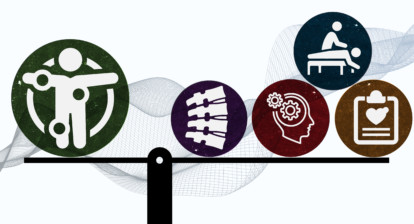How do we know – with irrefutable research and hard data – that someone who is living the chiropractic lifestyle is, in fact, healthier than the average person who is not receiving chiropractic care?
That is the question before a small, deeply dedicated group of scientists led by Life West’s Director of Research, Dr. Monica Smith. The research team includes Drs. Dale Johnson and Chuck Henderson, who with Dr. Smith have over 50 years of experience in chiropractic and clinical research.
“What we’re trying to capitalize on is current opportunity,” Dr. Smith said in a recent interview. Technology that can capture important data has advanced, as well as the science around objective measures of health, called biomarkers, that may provide the data to show how chiropractic associates with health and vitality improvements over time.
“One way to think about using any of this is to think about pre- and post- chiropractic intervention,” she said. If you measure before and after a regimen of chiropractic care, what do the biomarkers look like? How long does it take before you see a significant difference pre- and post-measurements?
Dr. Smith said most of the information about biomarkers is measuring health status in people with specific diseases. There isn’t a lot of available information about biomarker sensitivity and responsiveness in generally healthy individuals.
“We need biomarkers that can tell us if otherwise healthy people receiving chiropractic care (wellness/maintenance care) experience improved vitality and resilience,” she said. “Biomarkers that give us that information will allow us to bring together our philosophy and our science.”
So the Life West team is doing preliminary work “to get the juggernaut rolling,” such as conducting early feasibility studies to identify biomarkers that provide valid and reliable measures of the progress of a patient toward optimal health and vitality. In the course of moving forward with these early “capacity building” feasibility studies, the research department is also building a solid foundation and institutional capacity for carrying out a related responsibility: to ensure that the college’s growing cadre of clinical research scientists will conduct safe, ethical and scientifically defensible clinical research that are fully in compliance with all regulation and laws at the local, state and federal levels.
“The science is deep and interesting,” said Dr. Johnson. “Objective measures must be found to complement the patient-reported subjective measures.” Life West’s goal is to study the role of chiropractic care in achieving vitality and maintaining wellness in one’s life.
Some of the measurements that can be taken include comparing certain attributes in different populations. For example, the portfolio of biomarkers for clinical research at Life West includes telomeres, which is a part of the chromosome that indicates the rate, or pace, of cellular aging. Life West is developing a clinical epidemiology study that will compare the telomeres of those who were raised in a chiropractic lifestyle with other groups of various populations.
“This study design is looking at the group of interest, and how does that group compare to a group that doesn’t have those characteristics, or generally compare to the overall population,” Dr. Smith said. The comparison will look at age- and sex-matched controls in the general population to see how healthy the chiropractic lifestyle is in terms of telomeres, which help determine the biological age of the body as opposed to the chronological age.
Other measurable attributes that the team is looking at include sleep and heart rate variability (HRV). The team recently tested devices that track pulse rate and HRV during normal daily activities. They tested a 24-hour Holter® ECG paired with an Actiwatch® accelerometer device and are researching sleep attributes such as sleep latency, duration of sleep and sleep efficiency, in combination with the subject’s HRV.
Dr. Henderson said that current biomarkers tend to be disease-focused, such as blood tests for PSA or HbA1C. “We are interested in biomarkers that are sensitive to changes on the wellness side of the health spectrum,” he added.
Finding sensitive and valid measurement devices that are responsive in both the disease and wellness regions of the health spectrum is necessary to explore the full scope of health benefits associated with chiropractic care. But that doesn’t mean the team is limited by what’s available today, because technology is moving so quickly.
“Often people think about what you can measure and not measure,” Dr. Henderson said. “Science is all about what you can measure. Philosophy is about things you can’t directly measure. But there is, and always has been, an important overlap. Science and philosophy are interdependent. And, things we can’t measure today, we will be able to measure tomorrow.”








